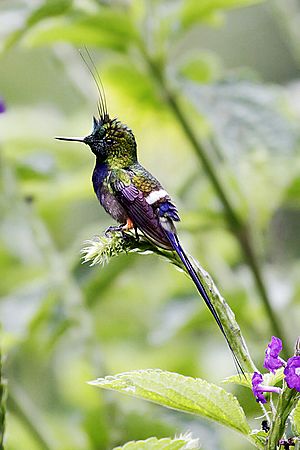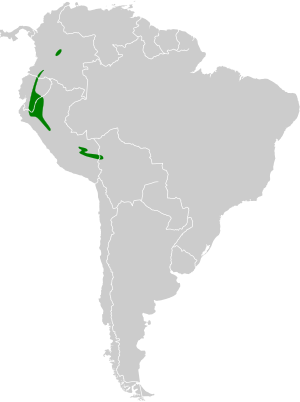Wire-crested thorntail facts for kids
Quick facts for kids Wire-crested thorntail |
|
|---|---|
 |
|
| near Manu Road, Peru | |
| Conservation status | |
| Scientific classification | |
| Genus: |
Discosura
|
| Species: |
popelairii
|
 |
|
| Synonyms | |
|
Popelairia popelairii |
|
The wire-crested thorntail (scientific name: Discosura popelairii) is a tiny and beautiful hummingbird. It belongs to a group of hummingbirds called "coquettes." You can find this special bird in countries like Colombia, Ecuador, Peru, and sometimes even Bolivia.
Contents
About the Wire-Crested Thorntail
The wire-crested thorntail is one of the smallest birds on Earth! An adult bird weighs only about 2.5 grams (that's like two paper clips!).
What Does It Look Like?
Male wire-crested thorntails are about 11.4 centimeters (4.5 inches) long. Females are a bit shorter, around 7.5 to 8.2 centimeters (3 to 3.2 inches).
Both male and female adults have shiny, coppery-green feathers on their backs. They also have a clear white stripe across their lower back, near their tail.
Male Birds
Male thorntails have a sparkling green head with a very thin, hair-like crest on top. This crest is how they get their "wire-crested" name! Their throat feathers are also a bright, iridescent green. Their sides are brownish with a white patch, and the rest of their belly is black.
The male's tail is a shiny blue, deeply forked, and the outer feathers are very narrow. This unique tail, along with the crest, makes the male look very special.
Female Birds
Female thorntails do not have the crest on their head. They have a wide white stripe on their cheek. Their belly is black with a white patch on their side. Their tail is short, only slightly forked, and is bluish-black with white tips.
Young birds look a lot like the adult females.
Where Do They Live?
The wire-crested thorntail lives in the foothills of the Andes Mountains. You can find them from eastern Colombia (in the Meta Department) through eastern Ecuador and into eastern Peru, as far south as the Puno Department. There has also been at least one sighting of this bird in Bolivia.
These hummingbirds prefer to live in the edges and inside of humid forests. They are usually found at elevations between 500 and 1500 meters (about 1,640 to 4,920 feet) above sea level.
How They Behave
Movement and Travel
Scientists believe that the wire-crested thorntail does not travel far. It usually stays in the same area its whole life.
What Do They Eat?
The wire-crested thorntail mainly eats nectar from flowers, especially those found high up in the forest canopy. They really like the flowers of Inga trees. Besides nectar, they also eat small arthropods, which are tiny insects and spiders.
Reproduction and Life Cycle
We don't know much about how wire-crested thorntails raise their young. Only one nest has ever been found. It was built on a tree branch about 8 meters (26 feet) above the ground.
How They Communicate
The only sound described for the wire-crested thorntail is a "quiet, somewhat liquid 'tew'."
Conservation Status
The IUCN (International Union for Conservation of Nature) says that the wire-crested thorntail is a species of "Least Concern." This means they are not currently in danger of disappearing. However, we don't know exactly how many of these birds there are or if their numbers are changing. Their forest home is "under severe threat of destruction," which means their habitat is being lost.
See also
 In Spanish: Rabudito Crestado para niños
In Spanish: Rabudito Crestado para niños


